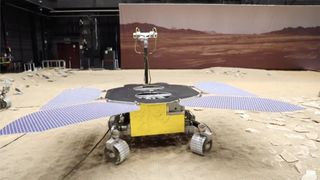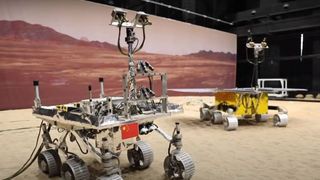
Tour China's 'Mars yard' for its Tianwen-1 rover mission (video)
To prepare for China's first Mars mission, Tianwen-1, the China Academy of Space Technology built a simulated Martian landscape on Earth and took the new rover out for a test drive.
The Tianwen-1 Mars mission, which launched to the Red Planet in July and aims to land a rover on the surface in April 2021 tested out the fake Martian terrain in a test bed at the China Academy of Space Technology (CAST) in Beijing, China.
The testing ground was renovated from a site that was initially used to simulate the lunar surface for China's moon rovers Yutu 1 and Yutu 2. The renovated testing ground comes complete with sand and stones to emulate various terrains on the Martian surface.
Video: See a Chinese rover tested on simulated Martian terrain
Related: NASA asteroid camera spots China's Tianwen-1 Mars spacecraft

Rover modes
As explained in a CCTV-Plus video, staff members used silicon carbides on the Earth and washed them with water to make sure they are clean enough to avoid contaminating the rover before it goes to Mars.
"On this site, we mainly test all [the rover's] working modes. We tested normal working mode and also its malfunction mode to see how it gets out of trouble when malfunction occurred. In fact, our testing ground served as an examination room before the final launch mission," said Jia Yong, an expert of China Aerospace Science and Technology Corporation (CASC), in a video interview.
China's Mars rover is very similar to the country's lunar rovers, but larger in size.
Get the Space.com Newsletter
Breaking space news, the latest updates on rocket launches, skywatching events and more!

"We must improve the autonomy of the rover. Besides, the environmental conditions of the Mars surface are probably more complicated than the moon. A result we can directly perceive through the eyes is that the rover is moving sideways, just like a crab, a feat the lunar rover incapable of," Teng Baoyi, deputy chief designer of CASC, said in the CCTV-Plus interview.
Difficult mission
In a related interview with CCTV, Liu Tongjie, deputy director of the Lunar Exploration and Space Program Center under the China National Space Administration (CNSA) said the Tianwen-1 mission — consisting of an orbiter, lander and a rover — is extremely difficult.
The spacecraft is expected to enter Mars orbit around February 2021. Afterwards, it will spend two to three months surveying potential landing sites by using a high-resolution camera to prepare for the landing in May.

The Tianwen-1 orbiter carries with it seven science instruments while the rover carries six.
When the probe arrives in February next year, "we will not let it land on the surface [of Mars] immediately. First, we will let it carry out some preliminary explorations [from orbit], making some trial operations and explorations. Then we will find a better window for it to make its landing," said Liu.
Related: Watch China simulate a Mars landing (video)

Northern hemisphere
The landing spot for the probe was carefully picked in accordance with the terrain of Mars.
"From what we've learned so far, the southern hemisphere of Mars is mountainous, while more plains are seen on the northern hemisphere. So we choose to make the landing on the latter. Right now we've picked the Utopia Planitia," Liu said.

Mars sample return
After the landing, the rover will be released to conduct scientific exploration with an expected lifespan of at least 90 Martian days (about three months on Earth), and the orbiter, with a design life of one Martian year (about 687 days on Earth), will relay communications for the rover while conducting its own scientific tasks.
As reported by the China Global Television Network (CGTN), China officials have suggested that if the Tianwen-1 and later this year the Chang'e 5 moon sample return mission go well, China could attempt to return samples from Mars beginning around 2030.
Also, check out this XinhuaVideo on what science tasks China's Mars mission is to carry out, focused on what the surface of Mars is made of:
Leonard David is author of "Moon Rush: The New Space Race" (National Geographic, 2019). A longtime writer for Space.com, David has been reporting on the space industry for more than five decades. Follow us on Twitter @Spacedotcom and on Facebook. This version of the story was published on Space.com.
Join our Space Forums to keep talking space on the latest missions, night sky and more! And if you have a news tip, correction or comment, let us know at: community@space.com.

Leonard David is an award-winning space journalist who has been reporting on space activities for more than 50 years. Currently writing as Space.com's Space Insider Columnist among his other projects, Leonard has authored numerous books on space exploration, Mars missions and more, with his latest being "Moon Rush: The New Space Race" published in 2019 by National Geographic. He also wrote "Mars: Our Future on the Red Planet" released in 2016 by National Geographic. Leonard has served as a correspondent for SpaceNews, Scientific American and Aerospace America for the AIAA. He was received many awards, including the first Ordway Award for Sustained Excellence in Spaceflight History in 2015 at the AAS Wernher von Braun Memorial Symposium. You can find out Leonard's latest project at his website and on Twitter.
